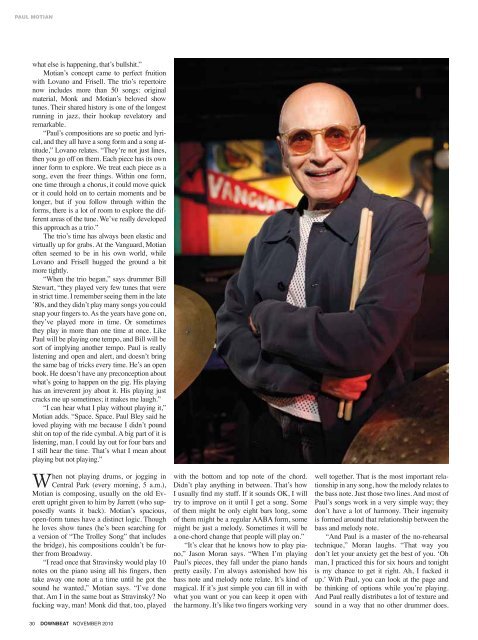You also want an ePaper? Increase the reach of your titles
YUMPU automatically turns print PDFs into web optimized ePapers that Google loves.
Paul motian<br />
what else is happening, that’s bullshit.”<br />
Motian’s concept came to perfect fruition<br />
with Lovano and Frisell. The trio’s repertoire<br />
now includes more than 50 songs: original<br />
material, Monk and Motian’s beloved show<br />
tunes. Their shared history is one of the longest<br />
running in jazz, their hookup revelatory and<br />
remarkable.<br />
“Paul’s compositions are so poetic and lyrical,<br />
and they all have a song form and a song attitude,”<br />
Lovano relates. “They’re not just lines,<br />
then you go off on them. Each piece has its own<br />
inner form to explore. We treat each piece as a<br />
song, even the freer things. Within one form,<br />
one time through a chorus, it could move quick<br />
or it could hold on to certain moments and be<br />
longer, but if you follow through within the<br />
forms, there is a lot of room to explore the different<br />
areas of the tune. We’ve really developed<br />
this approach as a trio.”<br />
The trio’s time has always been elastic and<br />
virtually up for grabs. At the Vanguard, Motian<br />
often seemed to be in his own world, while<br />
Lovano and Frisell hugged the ground a bit<br />
more tightly.<br />
“When the trio began,” says drummer Bill<br />
Stewart, “they played very few tunes that were<br />
in strict time. I remember seeing them in the late<br />
’80s, and they didn’t play many songs you could<br />
snap your fingers to. As the years have gone on,<br />
they’ve played more in time. Or sometimes<br />
they play in more than one time at once. Like<br />
Paul will be playing one tempo, and Bill will be<br />
sort of implying another tempo. Paul is really<br />
listening and open and alert, and doesn’t bring<br />
the same bag of tricks every time. He’s an open<br />
book. He doesn’t have any preconception about<br />
what’s going to happen on the gig. His playing<br />
has an irreverent joy about it. His playing just<br />
cracks me up sometimes; it makes me laugh.”<br />
“I can hear what I play without playing it,”<br />
Motian adds. “Space. Space. Paul Bley said he<br />
loved playing with me because I didn’t pound<br />
shit on top of the ride cymbal. A big part of it is<br />
listening, man. I could lay out for four bars and<br />
I still hear the time. That’s what I mean about<br />
playing but not playing.”<br />
When not playing drums, or jogging in<br />
Central Park (every morning, 5 a.m.),<br />
Motian is composing, usually on the old Everett<br />
upright given to him by Jarrett (who supposedly<br />
wants it back). Motian’s spacious,<br />
open-form tunes have a distinct logic. Though<br />
he loves show tunes (he’s been searching for<br />
a version of “The Trolley Song” that includes<br />
the bridge), his compositions couldn’t be further<br />
from Broadway.<br />
“I read once that Stravinsky would play 10<br />
notes on the piano using all his fingers, then<br />
take away one note at a time until he got the<br />
sound he wanted,” Motian says. “I’ve done<br />
that. Am I in the same boat as Stravinsky? No<br />
fucking way, man! Monk did that, too, played<br />
30 DOWNBEAT NOVEMBER 2010<br />
with the bottom and top note of the chord.<br />
Didn’t play anything in between. That’s how<br />
I usually find my stuff. If it sounds OK, I will<br />
try to improve on it until I get a song. Some<br />
of them might be only eight bars long, some<br />
of them might be a regular AABA form, some<br />
might be just a melody. Sometimes it will be<br />
a one-chord change that people will play on.”<br />
“It’s clear that he knows how to play piano,”<br />
Jason Moran says. “When I’m playing<br />
Paul’s pieces, they fall under the piano hands<br />
pretty easily. I’m always astonished how his<br />
bass note and melody note relate. It’s kind of<br />
magical. If it’s just simple you can fill in with<br />
what you want or you can keep it open with<br />
the harmony. It’s like two fingers working very<br />
well together. That is the most important relationship<br />
in any song, how the melody relates to<br />
the bass note. Just those two lines. And most of<br />
Paul’s songs work in a very simple way; they<br />
don’t have a lot of harmony. Their ingenuity<br />
is formed around that relationship between the<br />
bass and melody note.<br />
“And Paul is a master of the no-rehearsal<br />
technique,” Moran laughs. “That way you<br />
don’t let your anxiety get the best of you. ‘Oh<br />
man, I practiced this for six hours and tonight<br />
is my chance to get it right. Ah, I fucked it<br />
up.’ With Paul, you can look at the page and<br />
be thinking of options while you’re playing.<br />
And Paul really distributes a lot of texture and<br />
sound in a way that no other drummer does.

















